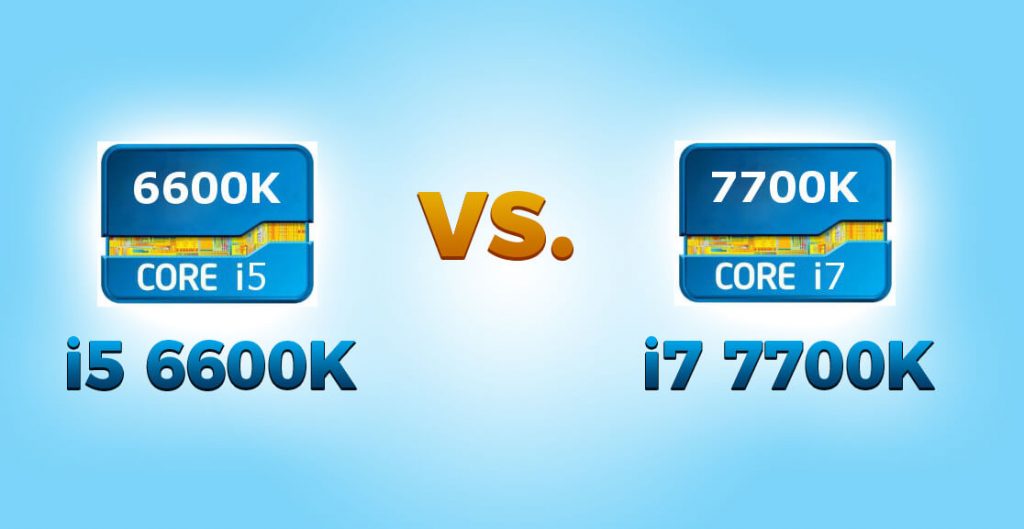i5 6600K vs i7 7700K Intel Core CPU Comparison Review

 |
 |
| Intel Core i5-6600K | Intel Core i7-7700K |
| 7.9/10 | 9.5/10 |
 |
 |
About the Intel Core i5-6600K Processor
The Intel Core i5 6600K 3.50 GHz Quad Core Processor was released in 2015, and is an Intel 6th Generation processor. 
The i5 is LGA 1151-compatible, so it’s compatible with all like-typed motherboards. It’s an unlocked quad-core processor, which means you can overclock at speeds that otherwise wouldn’t be possible on a processor with similar specs, making it a great steal for those who are major overclocking fans.
RAM Compatibility
The maximum memory size is 64GB, and the i5 is compatible with both DDR3L (1330/1600) and DDR4 (1866-2133) RAM. This is pretty cool, because it gives you some options when buying memory.
Graphics
The Graphics Base Frequency is 350MHz and the Graphics Max Dynamic Frequency is 1.15GHz; Graphics Video Max Memory caps at 64GB. In terms of graphics resolution, the Intel i5 offers 4K support at 60Hz with a Max Resolution of 4096×2304. It also features DirectX 12 support as well as support for Intel InTru 3D. These robust graphics features are big reason the Intel i5 Quad Core Processor remains a popular choice, despite already being a generation old as of 2017, primarily because you can still play new releases at ultra-high settings with the aid of the i5, depending on the rest of your setup, which is a big must-have feature for any serious gamer.
About the Intel i7-7700K Processor
The Intel i7 Quad Core Processor is a 7th generation processor from Intel, making it a whole generation newer, naturally, than the i5, which is a 6th generation processor. 
Like the i5, the i7 is also LGA 1151 compatible, which means it works with Skylake and Kaby Lake microarchitectures, as well as any other LGA 1151-compatible motherboard.
Overclocking
An unlocked, newer generation quad core processor, the i7 definitely features more overclocking potential than its i5 counterpart, thanks in large part to a much higher Base Processor Frequency (4.20GHz) and a much higher Max Turbo Frequency (4.50GHz). Both feature Intel’s Turbo Boost technology, but with i7 inherently operating at greater speeds, it’s an overclocking force to be reckoned with and, consequently, will definitely showcase a big productivity boost when it comes to doing any processor-heavy task, like HD video editing, 3D modeling and more.
Graphics
The Graphics specs on the Intel i7 are actually very comparable to the i5, but that doesn’t mean gamers won’t benefit from the i7; it’s simply a much faster piece of work, which will allow for quicker rendering when it comes to complex 3D modeling or playing graphics-heavy newer gaming titles. Another key difference in graphics between the i5 and the i7 is that the i7 is compatible with Intel HD Graphics 630 processor graphics, whereas i5 naturally uses a previous iteration.
RAM Compatibility
The i7 is compatible with both DDR3L-1330/1600 RAM; like the i5, it’s also DDR4 compatible, but it’s DDR4-2133/2400, essentially a new and improved version. (Meaning more efficient for demanding tasks, essentially.) Maximum memory is set to 64GB, which is still standard as of 2017; though higher max memory is believed to be theoretically possible, it’s just not necessary quite yet.
How do i5 6600k vs i7 7700K stack up head-to-head?
Though there are considerable differences between the i5 and the i7, let’s take a look at the things they have in common:
- Both use LGA 1151 sockets, which makes them both compatible with Intel Skylake’s microarchitecture, as well as Kaby Lake; the older LGA 1150 sockets are outdated, so this shared LGA 1151 feature is important, because it means they’re compatible with the same motherboards.
- Both processors are quad core processors.
- They are both are unlocked processors.
- Both CPUs have a maximum memory size of 64GB.
Both are compatible with DDR3L-1330/1600 @ 1.35V
- They both are DDR4 compatible (with different parameters, however).
- Both processors are limited to 2 memory channels as a maximum
- They both have same Graphics Base Frequency of 350MHz
- Both have same Graphics Max Dynamic Frequency of 1.15GHz
- Both have the same Graphics Video Max Memory of 64GB
- They offer 4K support at 60Hz
- Both share the same Max Resolution of 4096×2304
- They support DirectX 12
- Both support Intel InTru 3D Technology
- They support a maximum of 3 displays
- Both feature Intel Turbo Boost Technology 2.0
- Both have a 64-bit instruction set
So now that we know the similarities between the Intel Core 95 6600K vs i7 7700K, let us look at the differences.
Key differences between the Intel Core i5 6600K & Core i7 7700K
- Processor Graphics: i5 uses Intel HD Graphics 530; i7 uses Intel HD Graphics 630
- DDR4 RAM: i5 uses DDR4-1833/2133; i5 uses DDR4-2133/2400
- Base Processor Frequency: 3.50GHz for the i5; 4.20Ghz for the i7
- Max Turbo Frequency: 3.90GHz for the i5; 4.50GHz for the i7
- Cache: i5 uses 6MB SmartCache; i7 uses 8MB SmartCache
- Threads: i5 has 4 threads; i7 has 8 threads
- Max Resolution: While Max Resolution is nearly identical with both processors, the i5 goes down to 4096×2304@24Hz in HDMI 1.4 whereas i7 is a steady 4096×2304@60Hz in every mode.
Bottom Line – Which is Better between the i5 6600K vs i7 7700K
The Intel Core i5 and the Intel Core i7 share a lot of similarities, despite being a generation apart in both age and technology. 
When it comes to graphics, the i5 and the i7 are nearly identical. So, if all you do is watch movies or stream TV shows and very general stuff like that, you’ll be fine either way. But the slight difference in graphics, namely the i7’s Intel HD Graphics 630 make it a clear better choice for video, graphics and multimedia professionals. The Intel HD 630 graphics aren’t better because they’re newer, they’re better because they are. They’re better optimized for the graphic demands of today, which are only going to become more demanding as the years roll on, so professionals should seriously keep that in mind when stacking up the graphics of the two processors against each other.
Intel Core i7-7700K for Highest Processing Speed

But what does all of this processor speed mean to the average user, you may wonder. If a non-gamer is thinking about processors at all, it’s usually because they need a decent one for professional reasons. Many different jobs that were once analog are now digital, like film editing and fashion design and more. All of these are very intensive for your PC to pull off.
It requires a lot of power and processor efficiency. Simply put, an average user who just goes on social media and watches TV shows isn’t going to notice much of a difference between the processor speeds of the i5 6600k vs i7 7700K—but the professional will, especially the more stress their work puts on the PC.Essentially, the more strenuous the ask, the greater the difference you’ll see between the i5 and the i7 in terms of processor speed, because this is actually where it matters the most.
Using the CPUs for Gaming

One for the Future
What is futureproofing, you may ask? Well, in terms of computers it is, in a nutshell, crafting yourself a gaming rig that features specs beyond what you currently need in anticipation that those current needs you have will scale in a much more demanding direction as time goes on. So, you get a little more RAM than you think you need, for instance. (Not that I advocate for getting a ridiculous amount of RAM you don’t even need, but yeah.) It’s the same with processors. If an i5 is good for you now, but you want to futureproof your PC build, ask yourself: Is an i5 going to fit your needs in two or even five years? You have to think about the expected lifespan of your rig and how much (if any) you intend to upgrade it after it’s built—and when, if you do.
In general, the prudent thing to do is to err on the futureproof side. That still doesn’t answer the question of which is better, though. On that topic, I will now give my two cents.
Conclusion: i5 6600K vs i7 7700K
When looking at the i5 6600K vs i7 7700K objectively, the Intel Core i7 still brings so much more to the table. 
So to pick a winner between the i5 6600K vs i7 7700K. The Intel Core i7-7700K wins, being the far better CPU!
 |
 |
| Intel Core i5-6600K | Intel Core i7-7700K |
| 7.9/10 | 9.5/10 |
 |
 |

 Both are compatible with DDR3L-1330/1600 @ 1.35V
Both are compatible with DDR3L-1330/1600 @ 1.35V



